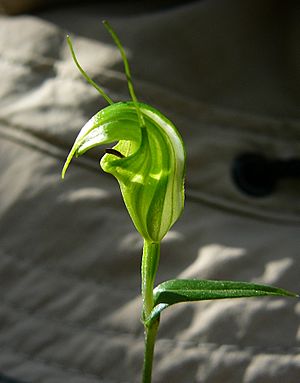Coastal greenhood facts for kids
Quick facts for kids Coastal greenhood |
|
|---|---|
 |
|
| Pterostylis alveata growing in Ben Boyd National Park | |
| Scientific classification | |
| Genus: |
Pterostylis
|
| Species: |
alveata
|
| Synonyms | |
|
|
The coastal greenhood (scientific name: Pterostylis alveata) is a special type of orchid. It grows only in south-eastern Australia. Like other greenhood orchids, these plants look different depending on whether they are flowering or not. If a coastal greenhood isn't flowering, it has a group of leaves that lie flat on the ground, like a circle. But when it's ready to bloom, it grows a single, shiny green and white flower on a tall stem, with a few leaves along the stem.
Contents
What Does the Coastal Greenhood Look Like?
The coastal greenhood is a plant that grows from an underground tuber (like a small potato). It lives for many years and loses its leaves at certain times.
Leaves and Stems
When the plant is not flowering, it has a group of dark green leaves arranged in a circle close to the ground. Each leaf is about 10 to 25 millimeters (about 0.4 to 1 inch) long and 5 to 15 millimeters (about 0.2 to 0.6 inches) wide.
When it flowers, a single flower grows on a stem that is 100 to 200 millimeters (about 4 to 8 inches) tall. This stem also has three to five leaves spread out along it.
The Flower
The coastal greenhood flower is shiny green and white. It is about 12 to 15 millimeters (about 0.5 to 0.6 inches) long and 7 to 10 millimeters (about 0.3 to 0.4 inches) wide.
- Hood (Galea): The top part of the flower, called the dorsal sepal, and the petals are joined together. They form a hood or "galea" over the central part of the flower, which is called the column. This hood curves forward and has a pointed tip.
- Side Parts (Lateral Sepals): The two side parts, called lateral sepals, are held close to the hood. They have a thin, thread-like tip that is 12 to 15 millimeters long. There's also a flat, sticking-out area between their bases.
- Lip (Labellum): The "lip" of the flower, called the labellum, is dark brown. It's about 8 to 9 millimeters long and 3 millimeters wide. You can just see it peeking out from under the main part of the flower.
Coastal greenhoods usually flower from May to June.
How Was it Named?
Scientists give every living thing a unique scientific name. This helps everyone around the world know exactly which plant or animal they are talking about.
The coastal greenhood was first officially described in 1939 by a scientist named John ("Ros") Garnet. He found a sample of the plant on Snake Island in Australia. His description was then published in a science magazine called The Victorian Naturalist.
The second part of its scientific name, alveata, comes from a Latin word. It means "hollowed out," which might describe a feature of the flower.
Where Does the Coastal Greenhood Grow?
The coastal greenhood grows in moist areas near the coast. You can find it among grasses in woodlands and scrubland. Its natural home stretches from Melbourne in Victoria up to Nelson Bay in New South Wales.

